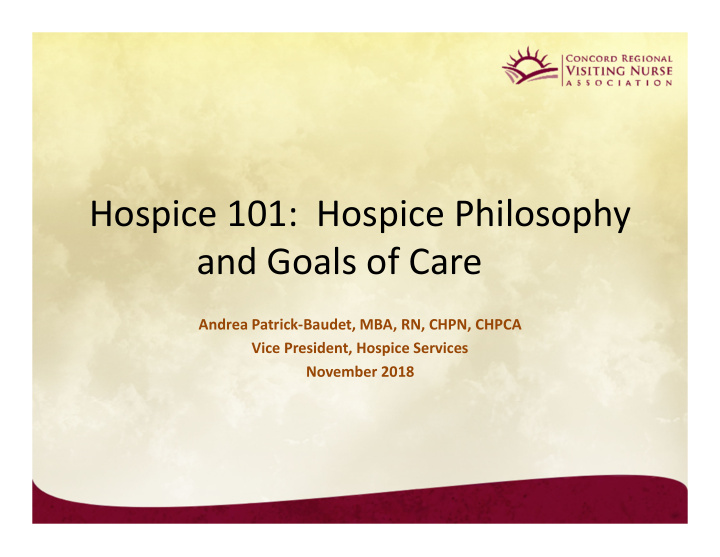



Hospice 101: Hospice Philosophy and Goals of Care Andrea Patrick‐Baudet, MBA, RN, CHPN, CHPCA Vice President, Hospice Services November 2018
Objectives Participants will be able to describe: Hospice Philosophy and goals of care What is covered (and not covered) under the hospice benefit
Facts and Figures Hospice Care in America, NHPCO 2017 Edition 1.43 million Medicare beneficiaries received hospice care for one or more days in 2016 Of all 2016 Medicare decedents, 48% received one or more days of hospice and were enrolled at time of death About 64% 80 yo or older 86.5% Caucasian, 8.3% African American, 2.1% Hispanic, 1.2% Asian
Facts and Figures Hospice Care in America, NHPCO 2017 Edition Principal dx: Cancer 27.2% Cardiac and Circulatory 18.7% Dementia 18% Respiratory 11% Stroke 9.5% Other 15.6%
Facts and Figures Hospice Care in America, NHPCO 2017 Edition ALOS 71 days MLOS 24 days 27.9% enrolled 7 days or less; 40% enrolled 14 days or less Average spending per Medicare hospice patient = $11, 820 Principal dx cancer: Mean 46 days/ Median 19 days
Facts and Figures Hospice Care in America, NHPCO 2017 Edition Location of care by % days of care: Home 44.6% Nursing Facility 32.8% Hospice Inpatient Facility 14.6% Acute Care Hospital 7.4% Other 0.7%
Facts and Figures Hospice Care in America, NHPCO 2017 Edition Level of care by % days of care: Routine 98% General Inpatient 1.5% Respite 0.3% Continuous Home Care 0.2%
Hospice Eligibility Anticipated six month or less prognosis if the illness takes its projected course Patient chooses to forego life prolonging, aggressive treatments for the terminal illness and related diagnoses Virtually all care provided or arranged by hospice team
Hospice Philosophy and Goals Palliative, not curative Focus on care and comfort, management of distressing symptoms Focus on quality of life, not quantity Neither postpones nor hastens death Education and support for family and other caregivers as well as patient
Delivery of Care Wherever patient lives Primary caregiver Hospice staff visits 24/7 availability Interdisciplinary team Individualized plan of care
Hospice Team Patient’s attending provider Hospice Medical Director RN, LPN, LNA MSW Spiritual Care Volunteers Bereavement
What Services Does Hospice Provide? Expert pain and symptom management Anticipatory guidance: assist patient/family with the physical, emotional, and spiritual aspects of dying Medications and medical equipment Instruct family/caregivers how to provide care Short term inpatient and respite care as needed PT/OT/SLP Grief support
Who Pays For Hospice Care? Medicare Medicaid Private Insurers Self pay/reduced or free care Current payment structure is a daily rate based on level of care Medicare covers 100% of hospice services, no copay or OOP
What is NOT Covered? Nursing facility room and board Care unrelated to terminal or related diagnoses Care sought without consulting hospice team Non‐formulary medications and supplies Curative or aggressive cares
The Problem of Prognostication 343 physicians/468 terminally ill patients Median survival 24 days 20% of predictions accurate 63% overly optimistic 17% overly pessimistic Physicians overestimated survival by a factor of 5.3. Longer MD/patient relationship=less accurate prognosis (Christakis, et al. BMJ 2000 )
Performance Status Significant predictor of survival in advanced cancer Karnofsky Performance Status (KPS) and Eastern Cooperative Oncology Group (ECOG) scales good reliability/validity KPS <60, ECOG >2= median survival 6 months or less for any advanced solid cancer (Salpeter, et al. J Palliat Med . 2012)
Barriers To Care Fear of taking away hope Death=Failure I don’t want to disappoint my family/my doctor Misconceptions about hospice Lack of consistency between programs
Questions? "You matter because you are you, and you matter to the end of your life. We will do all we can not only to help you die peacefully, but also to live until you die.” — Dame Cicely Saunders, nurse, physician and writer, and founder of hospice movement (1918 ‐ 2005). "Life is pleasant. Death is peaceful. It's the transition that's troublesome." – Isaac Asimov, American science fiction novelist & scholar (1920 ‐ 1992).
References NHPCO Facts and Figures: Hospice Care in America. Rev. ed. April 2018. https://www.nhpco.org/sites/default/files/public/Statistics _Research/2017_Facts_Figures.pdf (last accessed August 16, 2018). Salpeter, SR, Malter DS, Luo EJ, Lin AY, Stuart B. Systematic review of cancer presentations with a median survival of six months or less. J Palliat Med. 2012 Feb; 15 (2) 375‐385. Temel JS, Greer JA, Muzikansky A, Gallagher ER, Admane S, Jackson VA, Dahlin CM, Blinderman CD, Jacobsen J, Pirl WF, Billings JA, Lynch TJ: Early palliative care for patients with metastatic non‐small‐cell lung cancer. N Engl J Med 2010; 363: 733‐742.
Post‐Test Q +A 1. True/False: Curative treatment is a fundamental component of hospice care. (False) 2. True/False: A patient is considered "terminal" if a physician, using their best clinical judgment, determines that their prognosis is six months or less, if the disease takes its predicted course. (True) 3. True/False: The imprecise nature of prognostication, with an inclination to overestimate life expectancy, is a barrier to timely hospice care. (True)
Recommend
More recommend